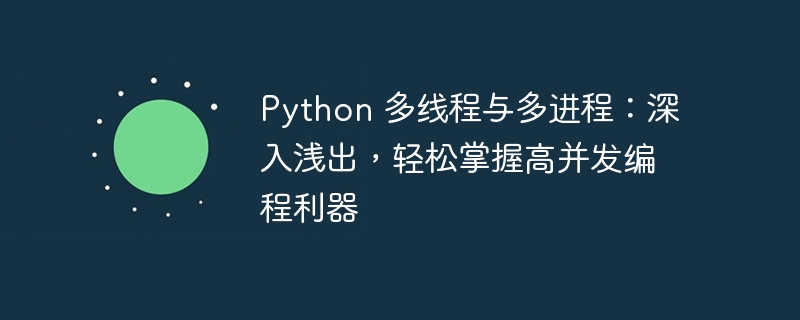Home >Backend Development >Python Tutorial >Python multi-threading and multi-process: explain it in simple terms and easily master high-concurrency programming tools
Python multi-threading and multi-process: explain it in simple terms and easily master high-concurrency programming tools
- 王林forward
- 2024-02-25 09:10:331250browse

pythonMulti-threading and multi-process are two different parallel programming technologies, both of which can be used for writing efficient and scalable applications. MultiThreading refers to creating multiple threads in one process, while multi-process refers to creating multiple processes.
Multithreading
Multi-threading is achieved by creating multiple threads in a single process. Concurrent programming. Each thread is an independent execution stream and they share the same memory space. This means that threads can easily access and modify each other's data. However, multithreading also has some disadvantages. First, multithreading can lead to race conditions, which are data inconsistencies when multiple threads access shared data at the same time. Secondly, multi-threading may also lead to dead locks, which is a stalemate caused by multiple threads waiting for each other to release resources. multi-Progress
Multiple processes realize
concurrencyprogramming by creating multiple processes. Each process is an independent memory space, and they communicate with each other through the inter-process communication (IPC) mechanism. The advantage of multiple processes is that it avoids race conditions and deadlocks because each process has its own independent memory space. However, multi-process also has a disadvantage, that is, it is more expensive, because creating and destroying a process requires a certain amount of time and resources. How to choose to use multi-threading or multi-process
When choosing to use multi-threading or multi-process, you need to consider the following factors:
Type of task: If the task is computationally intensive, then multi-threading can be used. If the task is I/O intensive, multiple processes can be used.
- Data sharing: If tasks need to share data, multi-threading can be used. If tasks do not require shared data, multiple processes can be used.
- Degree of concurrency: If high concurrency
- applications are required, then multi-threading can be used. If an application does not require high concurrency, then multi-processing can be used. Demo code
The following is a code example that demonstrates
Python multi-threading and multi-process:
# 多线程示例
import threading
def task(arg):
print(f"Task {arg} is running.")
threads = []
for i in range(10):
thread = threading.Thread(target=task, args=(i,))
threads.append(thread)
for thread in threads:
thread.start()
for thread in threads:
thread.join()
# 多进程示例
import multiprocessing
def task(arg):
print(f"Task {arg} is running.")
processes = []
for i in range(10):
process = multiprocessing.Process(target=task, args=(i,))
processes.append(process)
for process in processes:
process.start()
for process in processes:
process.join()
In the above code example, we created 10 threads and 10 processes, each of which performs a simple task. You can run the code and watch multi-threads and processes in action.
Python's multithreading and multiprocessing are powerful
toolsthat can help you write efficient and scalable applications. When choosing between using multithreading or multiprocessing, you need to consider the type of tasks, the sharing of data, and the degree of concurrency. This article introduces the basic principles, advantages, disadvantages, and usage scenarios of Python multithreading and multiprocessing, and demonstrates how to use multithreading and multiprocessing through demonstration code. I hope this article can help you master Python's multi-threading and multi-process in a simple way, easily master high-concurrency programming tools, and significantly improve code execution efficiency.
The above is the detailed content of Python multi-threading and multi-process: explain it in simple terms and easily master high-concurrency programming tools. For more information, please follow other related articles on the PHP Chinese website!
Related articles
See more- Detailed explanation of how to use thread pool in java concurrent programming
- Detailed introduction to python multi-process (with examples)
- PHP multi-process, semaphores, orphan processes and zombie processes
- Several ways to implement multithreading in java
- Golang concurrent programming tool: Decrypting the memory management mechanism of Goroutines

